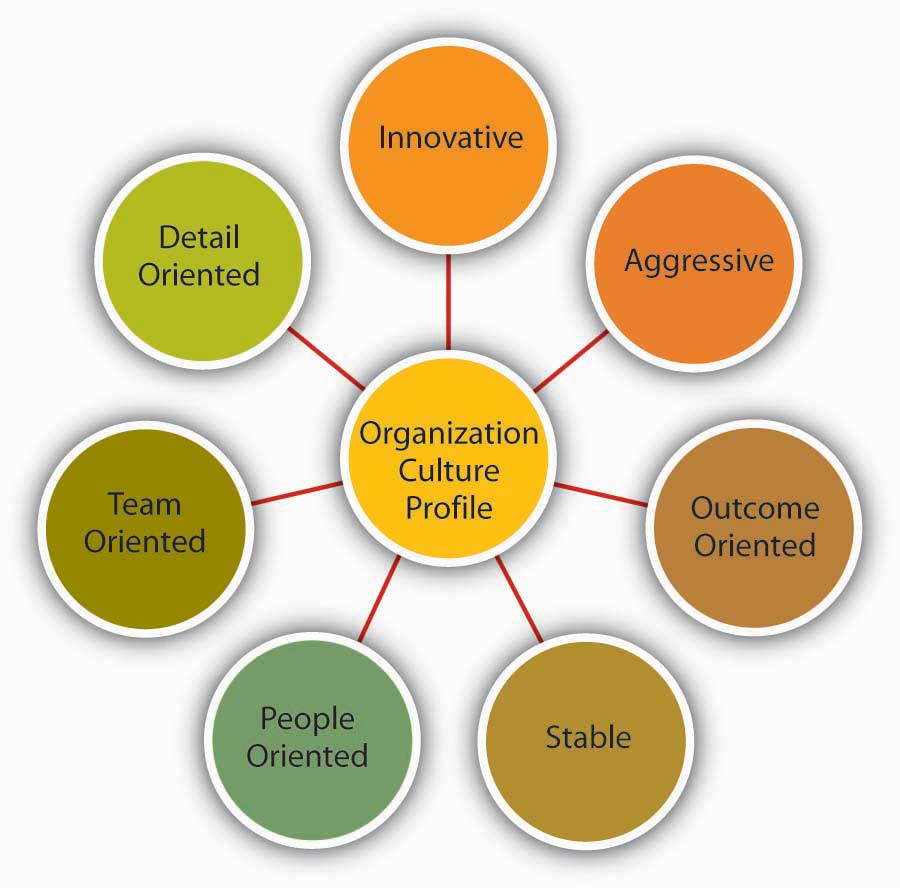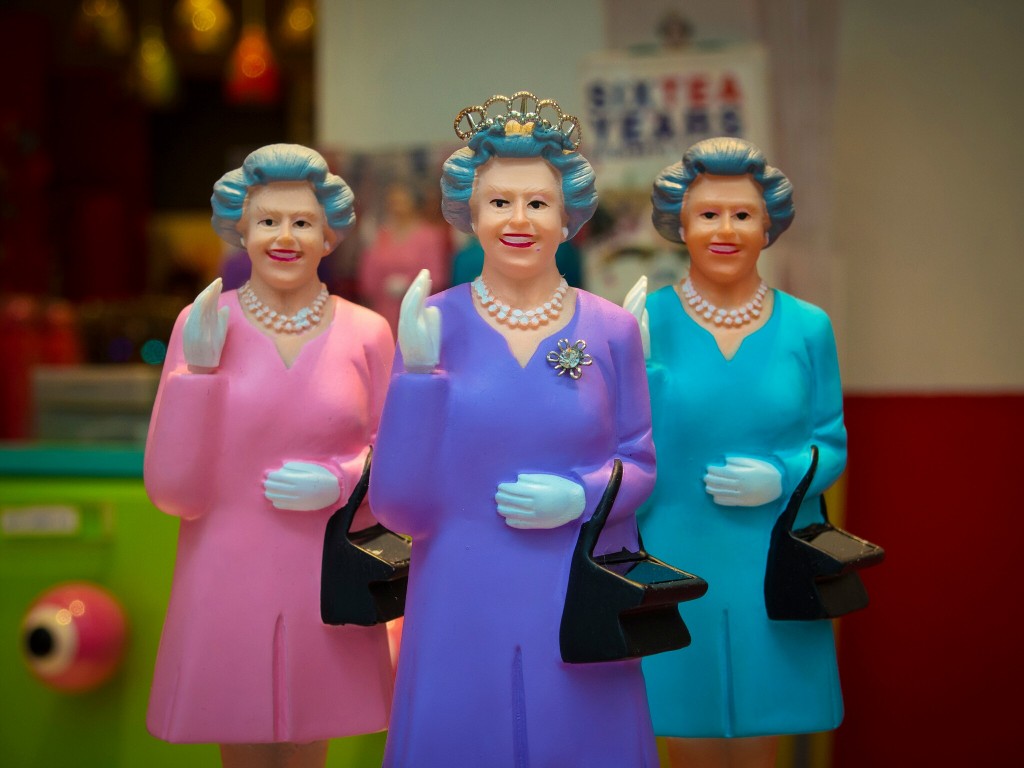8.4: Measuring Organizational Culture
- Page ID
- 4810
Learning Objectives
- Understand different dimensions of organizational culture.
- Understand the role of culture strength.
- Explore subcultures within organizations.
Dimensions of Culture
Which values characterize an organization’s culture? Even though culture may not be immediately observable, identifying a set of values that might be used to describe an organization’s culture helps us identify, measure, and manage culture more effectively. For this purpose, several researchers have proposed various culture typologies. One typology that has received a lot of research attention is the Organizational Culture Profile (OCP) where culture is represented by seven distinct values (Chatman & Jehn, 1991; O’Reilly, et. al., 1991).
Figure 8.6 Dimensions of Organizational Culture Profile (OCP)

Adapted from information in O’Reilly, C. A., III, Chatman, J. A., & Caldwell, D. F. (1991). People and organizational culture: A profile comparison approach to assessing person-organization fit. Academy of Management Journal, 34, 487–516.
Innovative Cultures
According to the OCP framework, companies that have innovative cultures are flexible, adaptable, and experiment with new ideas. These companies are characterized by a flat hierarchy and titles and other status distinctions tend to be downplayed. For example, W. L. Gore & Associates is a company with innovative products such as GORE-TEX® (the breathable fabric that is windproof and waterproof), Glade dental floss, and Elixir guitar strings, earning the company the distinction as the most innovative company in the United States by Fast Company magazine in 2004. W. L. Gore consistently manages to innovate and capture the majority of market share in a wide variety of industries, in large part because of its unique culture. In this company, employees do not have bosses in the traditional sense, and risk taking is encouraged by celebrating failures as well as successes (Deutschman, 2004). Companies such as W. L. Gore, Genentech, and Google also encourage their employees to take risks by allowing engineers to devote 20% of their time to projects of their own choosing.
Aggressive Cultures
Companies with aggressive cultures value competitiveness and outperforming competitors; by emphasizing this, they often fall short in corporate social responsibility. For example, Microsoft is often identified as a company with an aggressive culture. The company has faced a number of antitrust lawsuits and disputes with competitors over the years. In aggressive companies, people may use language such as “we will kill our competition.” In the past, Microsoft executives made statements such as “we are going to cut off Netscape’s air supply…Everything they are selling, we are going to give away,” and its aggressive culture is cited as a reason for getting into new legal troubles before old ones are resolved (Greene, et. al., 2004; Schlender, 1998).
Figure 8.7

Microsoft, the company that Bill Gates co-founded, has been described as having an aggressive culture.
IsaacMao – Bill Gates world’s most “spammed” person – CC BY 2.0.
Outcome-Oriented Cultures
The OCP framework describes outcome-oriented cultures as those that emphasize achievement, results, and action as important values. A good example of an outcome-oriented culture may be the electronics retailer Best Buy. Having a culture emphasizing sales performance, Best Buy tallies revenues and other relevant figures daily by department. Employees are trained and mentored to sell company products effectively, and they learn how much money their department made every day (Copeland, 2004). In 2005, the company implemented a Results Oriented Work Environment (ROWE) program that allows employees to work anywhere and anytime; they are evaluated based on results and fulfillment of clearly outlined objectives (Thompson, 2005). Outcome-oriented cultures hold employees as well as managers accountable for success and use systems that reward employee and group output. In these companies, it is more common to see rewards tied to performance indicators as opposed to seniority or loyalty. Research indicates that organizations that have a performance-oriented culture tend to outperform companies that are lacking such a culture (Nohria, et. al., 2003). At the same time, when performance pressures lead to a culture where unethical behaviors become the norm, individuals see their peers as rivals, and short-term results are rewarded, the resulting unhealthy work environment serves as a liability (Probst & Raisch, 2005).
Stable Cultures
Stable cultures are predictable, rule-oriented, and bureaucratic. When the environment is stable and certain, these cultures may help the organization to be effective by providing stable and constant levels of output (Westrum, 2004). These cultures prevent quick action and, as a result, may be a misfit to a changing and dynamic environment. Public sector institutions may be viewed as stable cultures. In the private sector, Kraft Foods is an example of a company with centralized decision making and rule orientation that suffered as a result of the culture-environment mismatch (Thompson, 2006). Its bureaucratic culture is blamed for killing good ideas in early stages and preventing the company from innovating. When the company started a change program to increase the agility of its culture, one of its first actions was to fight bureaucracy with more bureaucracy: The new position of vice president of “business process simplification” was created but was later eliminated (Boyle, 2004; Thompson, 2005; Thompson, 2006).
People-Oriented Cultures
People-oriented cultures value fairness, supportiveness, and respecting individual rights. In these organizations, there is a greater emphasis on and expectation of treating people with respect and dignity (Erdogan, et. al., 2006). One study of new employees in accounting companies found that employees, on average, stayed 14 months longer in companies with people-oriented cultures (Sheridan, 1992). Starbucks is an example of a people-oriented culture. The company pays employees above minimum wage, offers health care and tuition reimbursement benefits to its part-time as well as full-time employees, and has creative perks such as weekly free coffee for all associates. As a result of these policies, the company benefits from a turnover rate lower than the industry average (Weber, 2005).
Team-Oriented Cultures
Companies with a team-oriented culture are collaborative and emphasize cooperation among employees. For example, Southwest Airlines facilitates a team-oriented culture by cross-training its employees so that they are capable of helping one another when needed. The company also emphasizes training intact work teams (Bolino & Turnley, 2003). In Southwest’s selection process, applicants who are not viewed as team players are not hired as employees (Miles & Mangold, 2005). In team-oriented organizations, members tend to have more positive relationships with their coworkers and particularly with their managers (Erdogan, et. al., 2006).
Figure 8.8

The growth in the number of passengers flying with Southwest Airlines from 1973 until 2007 when Southwest surpassed American Airlines as the most flown U.S. airline. While price has played a role in this, their emphasis on service has been a key piece of their culture and competitive advantage.
Adapted from http://upload.wikimedia.org/wikipedia/commons/6/69/Southwest-airlines-passengers.jpg
Detail-Oriented Cultures
Figure 8.9

Remember that, in the end, culture is really about people.
Chris Jones – Culture in the UK – CC BY-NC 2.0.
Organizations with a detail-oriented culture are characterized in the OCP framework as emphasizing precision and paying attention to details. Such a culture gives a competitive advantage to companies in the hospitality industry by helping them differentiate themselves from others. For example, Four Seasons and Ritz Carlton are among hotels who keep records of all customer requests such as which newspaper the guest prefers or what type of pillow the customer uses. This information is put into a computer system and used to provide better service to returning customers. Any requests hotel employees receive, as well as overhear, might be entered into the database to serve customers better.


